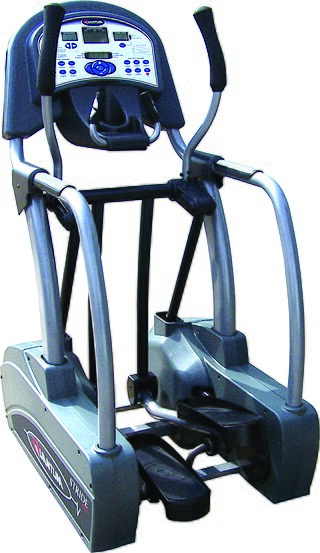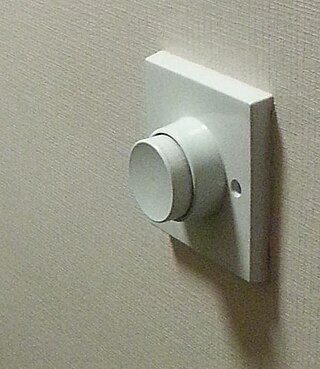Related Research Articles

An indoor rower, or rowing machine, is a machine used to simulate the action of watercraft rowing for the purpose of exercise or training for rowing. Modern indoor rowers are often known as ergometers because they measure work performed by the rower. Indoor rowing has become established as a sport, drawing a competitive environment from around the world. The term "indoor rower" also refers to a participant in this sport.

A piston is a component of reciprocating engines, reciprocating pumps, gas compressors, hydraulic cylinders and pneumatic cylinders, among other similar mechanisms. It is the moving component that is contained by a cylinder and is made gas-tight by piston rings. In an engine, its purpose is to transfer force from expanding gas in the cylinder to the crankshaft via a piston rod and/or connecting rod. In a pump, the function is reversed and force is transferred from the crankshaft to the piston for the purpose of compressing or ejecting the fluid in the cylinder. In some engines, the piston also acts as a valve by covering and uncovering ports in the cylinder.

A shock absorber or damper is a mechanical or hydraulic device designed to absorb and damp shock impulses. It does this by converting the kinetic energy of the shock into another form of energy which is then dissipated. Most shock absorbers are a form of dashpot.
An actuator is a component of a machine that is responsible for moving and controlling a mechanism or system, for example by opening a valve. In simple terms, it is a "mover".

Fluid power is the use of fluids under pressure to generate, control, and transmit power. Fluid power is conventionally subdivided into hydraulics and pneumatics. Although steam is also a fluid, steam power is usually classified separately from fluid power. Compressed-air and water-pressure systems were once used to transmit power from a central source to industrial users over extended geographic areas; fluid power systems today are usually within a single building or mobile machine.

Hydropneumatic suspension is a type of motor vehicle suspension system, designed by Paul Magès, invented by Citroën, and fitted to Citroën cars, as well as being used under licence by other car manufacturers, notably Rolls-Royce, Bmw 5-Series e34 Touring, Maserati and Peugeot. It was also used on Berliet trucks and has been used on Mercedes-Benz cars, where it is known as Active Body Control. The Toyota Soarer UZZ32 "Limited" was fitted with a fully integrated four-wheel steering and a complex, computer-controlled hydraulic Toyota Active Control Suspension in 1991. Similar systems are also widely used on modern tanks and other large military vehicles. The suspension was referred to as fr:Suspension oléopneumatique in early literature, pointing to oil and air as its main components.

Hydraulic machines use liquid fluid power to perform work. Heavy construction vehicles are a common example. In this type of machine, hydraulic fluid is pumped to various hydraulic motors and hydraulic cylinders throughout the machine and becomes pressurized according to the resistance present. The fluid is controlled directly or automatically by control valves and distributed through hoses, tubes, or pipes.
A dashpot, also known as a damper, is a mechanical device that resists motion via viscous friction. The resulting force is proportional to the velocity, but acts in the opposite direction, slowing the motion and absorbing energy. It is commonly used in conjunction with a spring. The process and instrumentation diagram (P&ID) symbol for a dashpot is .
A swimming machine, or resistance swimming apparatus, is a self-contained, pump-driven machine, that enables an athlete or recreational user to swim in place. A swimming machine is possible by accelerating the water past the swimmer or by supporting the swimmer, either in water or on dry land. One type of swimming machine, known as a countercurrent swimming machine, consists of a water tank at least twice as long and about one and a half times as wide as an average person with the limbs extended. The swimmer swims unrestrained against an adjustable stream of water using jets, propellers, or paddle wheels.

The history of fluid mechanics is a fundamental strand of the history of physics and engineering. The study of the movement of fluids and the forces that act upon them dates back to pre-history. The field has undergone a continuous evolution, driven by human dependence on water, meteorological conditions and internal biological processes.

A hydraulic brake is an arrangement of braking mechanism which uses brake fluid, typically containing glycol ethers or diethylene glycol, to transfer pressure from the controlling mechanism to the braking mechanism.

A hydraulic cylinder is a mechanical actuator that is used to give a unidirectional force through a unidirectional stroke. It has many applications, notably in construction equipment, manufacturing machinery, elevators, and civil engineering. A hydraulic cylinder is a hydraulic actuator that provides linear motion when hydraulic energy is converted into mechanical movement. It can be likened to a muscle in that, when the hydraulic system of a machine is activated, the cylinder is responsible for providing the motion.

An exercise machine is any machine used for physical exercise. These range from simple spring-like devices to computerized electromechanical devices to recirculating-stream swimming pools. Most exercise machines incorporate an ergometer. An ergometer is an apparatus for measuring the work a person exerts while exercising as used in training or cardiac stress tests or other medical tests.

An axial piston pump is a positive displacement pump that has a number of pistons in a circular array within a cylinder block. It can be used as a stand-alone pump, a hydraulic motor or an automotive air conditioning compressor.
Universal Gym Equipment was an American manufacturer of exercise equipment, in particular weight machines. It was founded by Harold Zinkin in 1957. In 1998, it was acquired by Flexible Flyer. In 2006 it was acquired by Nautilus, Inc. The Universal Gym brand was subsequently discontinued except for a line of selectorized dumbbells.

A hydraulic motor is a mechanical actuator that converts hydraulic pressure and flow into torque and angular displacement (rotation). The hydraulic motor is the rotary counterpart of the hydraulic cylinder as a linear actuator. Most broadly, the category of devices called hydraulic motors has sometimes included those that run on hydropower but in today's terminology the name usually refers more specifically to motors that use hydraulic fluid as part of closed hydraulic circuits in modern hydraulic machinery.

A pressure switch is a form of switch that operates an electrical contact when a certain set fluid pressure has been reached on its input. The switch may be designed to make contact either on pressure rise or on pressure fall. Pressure switches are widely used in industry to automatically supervise and control systems that use pressurized fluids.

Originally designed in 1966 by Leonard R Jordan Jr, the steering damper or steering stabiliser is a damping device designed to inhibit an undesirable, uncontrolled movement or oscillation of a vehicle steering mechanism, a phenomenon known in motorcycling as the death wobble. The stabilizer absorbs unwanted energy in the side to side motion allowing the forks and shocks to work properly. Many things can cause a motorcycle chassis to get upset such as slamming on brakes, rough road, and lastly improper setup. An upset chassis can be a great deal of danger for the rider often times resulting in a crash. A steering stabilizer slows those movements down resulting in the rider feeling more comfortable on the motorcycle.

An oleo strut is a pneumatic air–oil hydraulic shock absorber used on the landing gear of most large aircraft and many smaller ones. This design cushions the impacts of landing and damps out vertical oscillations.

The first automatic timer, the dashpot timer has been used in many different machines and has many variations. Pneumatic, hydraulic-action, and mercury displacement timers. Being used in a variety of things such as printing presses, motors, and even irrigation systems, the dashpot timer has seen many applications. Even in modern times with electrical and digital timers, these old mechanical timers are still in use due to their simplicity and ability to function in tough environments.
References
- ↑ "How Hydraulic Machines Work". HowStuffWorks. 2000-04-01. Archived from the original on 5 July 2021. Retrieved 2021-08-04.
- ↑ "HealthMax Pro Home Gym Customer Service". www.healthfxamerica.com. Archived from the original on 4 August 2021. Retrieved 2021-08-04.